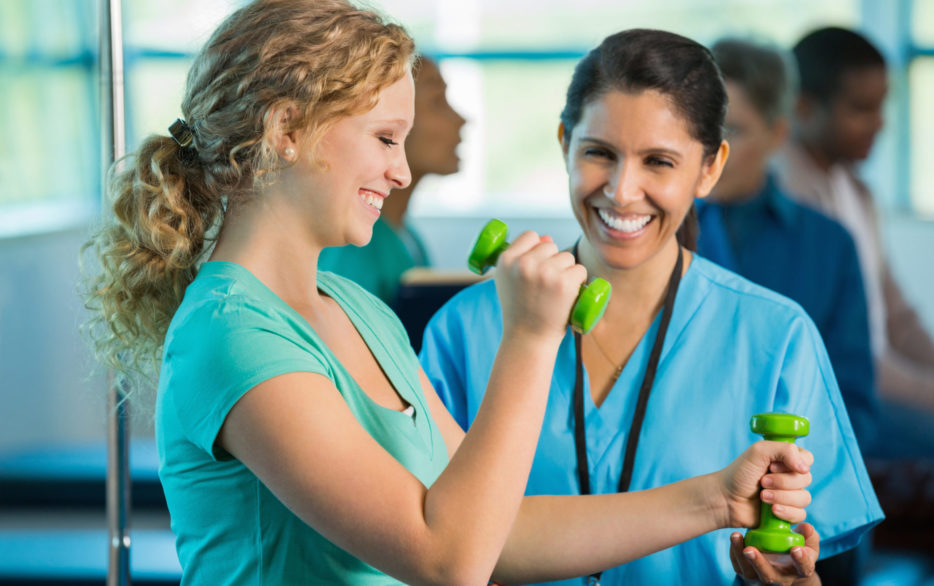Though certainly not fun, the pain from cuts, bruises and other run-of-the-mill childhood injuries is typically short-lived. But a 2016 study released in the peer-reviewed journal Children[1] reports that for at least 20 percent of kids and adolescents worldwide, pain is a nearly ever-present part of day-to-day life.
When a child experiences chronic pain, their nervous system is distributing pain signals where they aren’t needed — either an initial injury or illness has already healed, or there is no clear biological source. This misfiring causes discomfort that can continue for weeks, months or years. “Chronic pain in kids can affect one area of the body, such as the head or a hand, or be far more widespread. For many children, their chronic pain becomes completely debilitating,” says Anke Reineke, PhD, director of the Children’s Specialized Hospital Chronic Pain Management Program at Rady Children’s Hospital-San Diego. “Often, kids have trouble regularly attending school or participating in activities, and some can’t sleep or even tolerate light skin contact because their pain is so severe.”
The program Dr. Reineke oversees is the result of a recent Rady Children’s partnership with New Jersey’s Children’s Specialized Hospital, part of RWJBarnabas Health. In order to address the growing demand for youth-centric chronic pain care and better serve the needs of kids and teens facing chronic pain in the region, the inpatient initiative — the first of its kind in Southern California — emphasizes pain management through a whole-person, multidisciplinary approach and expands upon Children’s Specialized Hospital’s proven Chronic Pain Management Program.
At a time when opioid use has gripped the nation, participants follow the Children’s Specialized Hospital model of opioid- and pain medication-free chronic pain management. The approximately 28-day program integrates physiatry; psychology; and physical, occupational, recreational and aquatic therapy. Treatments include traditional, clinical methods along with options such as music and art through the Rady Children’s Healing Arts Program and yoga and acupuncture through the Rady Children’s Integrative Medicine Program, based on each patient’s case. This approach also contributes to a major goal of Rady Children’s — reducing overall Hospital opioid use while maintaining effective pain control. Over a two-year period, an institution-wide quality improve initiative reduced the number of ambulatory pediatric opioid prescriptions by 36 percent and ambulatory doses prescribed by 59 percent. “Particularly with such a young patient demographic, eliminating opioid prescriptions in pain management is critical in reducing overuse and abuse on a national level, and in providing patients with customized pain coping strategies to regain function and support long-term management and self-sufficiency,” says Dr. Reineke.
Providers collaborate across specialties on comprehensive, individualized care plans designed to help patients improve daily function, reduce pain, enhance self-awareness and adopt alternative coping strategies. Ultimately, the goal is to arm patients with tools that support overall wellness and mitigate flare-ups or relapse when they complete the program, and to have those tools serve them for life. In the aforementioned Children article, researchers indicate that leaving childhood chronic pain untreated often predisposes youth for developing mental health or additional pain disorders as adults. For example, authors reference a 2013 study that found 17 percent of adult participants with chronic pain experienced similar issues as children or teens. Eighty percent of those respondents also said their chronic pain began in childhood and continued into their adult years. Dr. Reineke and her colleagues recognize these implications, and make lasting relief for their patients a driving objective in their work. “When we help these kids refocus, gain a new perspective and take charge of their pain so they can get back to doing what they love, that’s a success,” she says. “We’re working together to retrain their bodies and brains and interrupt the cycle of pain.”
Since Rady Children’s launched the inpatient program in April 2019, four patients have “graduated” and returned to school, sports and favorite pastimes, and the care team looks forward to serving many more. For additional information on the program, visit our website.
Note: A version of this article appeared in the summer 2019 issue of Healthy Kids magazine
